
Kaunas is the second-largest city in Lithuania after Vilnius, the fourth largest city in the Baltic States and an important centre of Lithuanian economic, academic, and cultural life. Kaunas was the largest city and the centre of a county in the Duchy of Trakai of the Grand Duchy of Lithuania and Trakai Palatinate since 1413. In the Russian Empire, it was the capital of the Kaunas Governorate from 1843 to 1915.
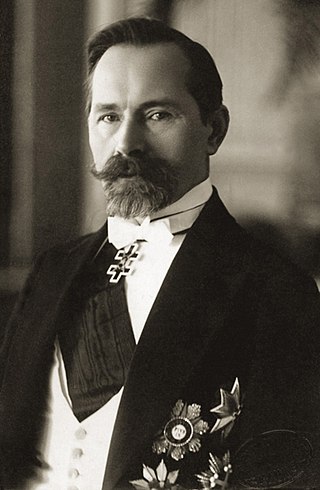
Antanas Smetona was a Lithuanian intellectual, journalist and politician who served as the first president of Lithuania from 1919 to 1920 and again from 1926 as a de facto dictator until the Soviet occupation of Lithuania in 1940. Referred to as the "Leader of the Nation" during his presidency, Smetona is recognised as one of the most important Lithuanian political figures between World War I and World War II, and a prominent ideologist of Lithuanian nationalism and the movement for national revival.
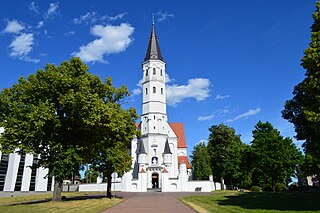
Šiauliai is a city in northern Lithuania, the country's fourth largest city and the sixth largest city in the Baltic States, with a population of 112 581 in 2024. From 1994 to 2010 it was the capital of Šiauliai County.

Antanas Merkys was the last Prime Minister of independent Lithuania, serving from November 1939 to June 1940. When the Soviet Union presented an ultimatum to Lithuania demanding that it accept a Soviet garrison, President Antanas Smetona fled the country leaving Merkys as acting president. Merkys ostensibly cooperated with the Soviets, and illegally took over the presidency in his own right. After three days, Merkys handed power to Justas Paleckis, who formed the People's Government of Lithuania. When Merkys attempted to flee the country, he was captured and deported to the interior of Russia, where he died in 1955.

Ukmergė is a city in Vilnius County, Lithuania, located 78 km (48 mi) northwest of Vilnius. It is the administratebe center of the Ukmergė District Municipality.

Tauragė is an industrial city in Lithuania, and the capital of Tauragė County. In 2020, its population was 21,520. Tauragė is situated on the Jūra River, close to the border with the Kaliningrad Oblast, and not far from the Baltic Sea coast.

Panevėžys is the fifth-largest city in Lithuania and the eighth-most-populous city in the Baltic States. As of 2021, it occupies 50 square kilometres (19 sq mi) with 89,100 inhabitants. As defined by Eurostat the population of the Panevėžys functional urban area that stretches beyond the city limits is estimated at 124,412.
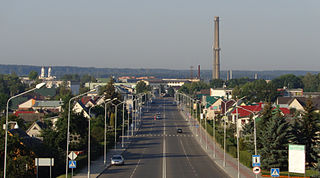
Jonava is the ninth largest city in Lithuania with a population of c. 30,000. It is located in Kaunas County in central Lithuania, 30 km (19 mi) north east of Kaunas, the second-largest city in Lithuania. It is served by Kaunas International Airport. Achema, the largest fertilizer factory in the Baltic states, is located nearby. The city is sometimes called "the capital of midsummer holiday".

Kuršėnai is a city in northwestern Lithuania, Šiauliai County, Šiauliai district municipality. It is the twenty-fifth largest city in Lithuania. According to the 2023 estimate, it had 10,651 residents.

Simnas is small town on the river Dovinė between Simnas and Giluitis lakes, in Alytus district, Alytus county, in the south of Lithuania. It lies on the 131 a national primary road from Alytus to Kalvarija. Simnas is located within the ethnographical region Dzūkija. According to the 2022 data, 1209 people live in the town with 3148 in Simnas eldership. It is most populous settlement in Alytus district.
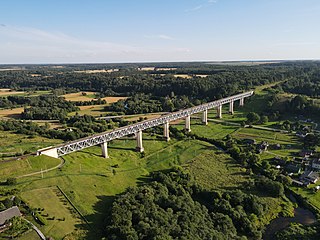
Lyduvėnai is a small town in the Šiluva Eldership, Raseiniai District Municipality, Kaunas County in central Lithuania. The town is 15 km north of Raseiniai and is near the confluence of the Dubysa and Dratvuo rivers. Lyduvėnai is the home of the longest and highest railway bridge in Lithuania, the Lyduvėnai Bridge. The town possesses the eldership's center, has a railway stop, a school, a library, in addition to post. The town's postal code is LT-60046. Lyduvėnai is situated in the Dubysa regional park and has its information center in the town's school. The railway line Šiauliai–Tilžė and the highways to Raseiniai and Šiluva pass through Lyduvėnai. Lyduvėnai is in the Dubysa valley, in contrast to other towns in the Dubysa basin.

Jašiūnai is a town in Lithuania. It is situated on the Merkys River and an edge of the Rūdninkai Forest. According to the 2001 census, it had population of 1,879. The town's population is primarily Poles (74.5%), with Lithuanians (12.4%) and Russians (8.4%).

Viešintos is a town in Anykščiai district municipality, in Utena County, in northeast Lithuania. According to the 2011 census, the town has a population of 281 people. Town established near Viešinta river.

Gelgaudiškis Manor is a former residential manor in Gelgaudiškis, Šakiai District Municipality, Lithuania.
Kęstaičiai is a village in Telšiai District Municipality, Lithuania. According to the 2011 census, it had 32 residents.

Vincas Vitkauskas was a Lithuanian general. He became commander of the Lithuanian Army after the resignation of Stasys Raštikis in January 1940. In this capacity, Vitkauskas opposed armed resistance to the Soviet occupation in June 1940 and subsequently collaborated with the new Soviet regime.

The Samogitian Diocese Museum is a museum dedicated to the former Diocese of Samogitia. Established in 1999, the museum is located in the building of the former Varniai Priest Seminary which was relocated to Kaunas after the failed Uprising of 1863. The museum is a branch of the Samogitian Museum Alka based in Telšiai.

Mikas Rėklaitis was a Lithuanian division general. He was chief of supply of the Lithuanian Armed Forces.
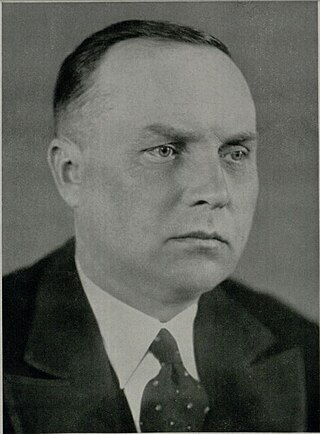
Jonas Lapėnas was a Lithuanian businessman and activist of the Lithuanian Nationalist Union. He was director of the meat processing and export company Maistas and chairman of the cooperative union Lietūkis. He was chairman of the Nationalist Union in 1929–1931.

Antanavas is a village in Marijampolė County, Lithuania, the center of an eldership. The village belongs to the Kazlų Rūda Municipality and is located about 15 kilometers south-west of Kazlų Rūda. The river Pilvė flows along the northern edge of the village. Near Antanavas there is a hydroelectric power station. According to the 2021 Lithuanian census, the village had a population of 562 residents.

























